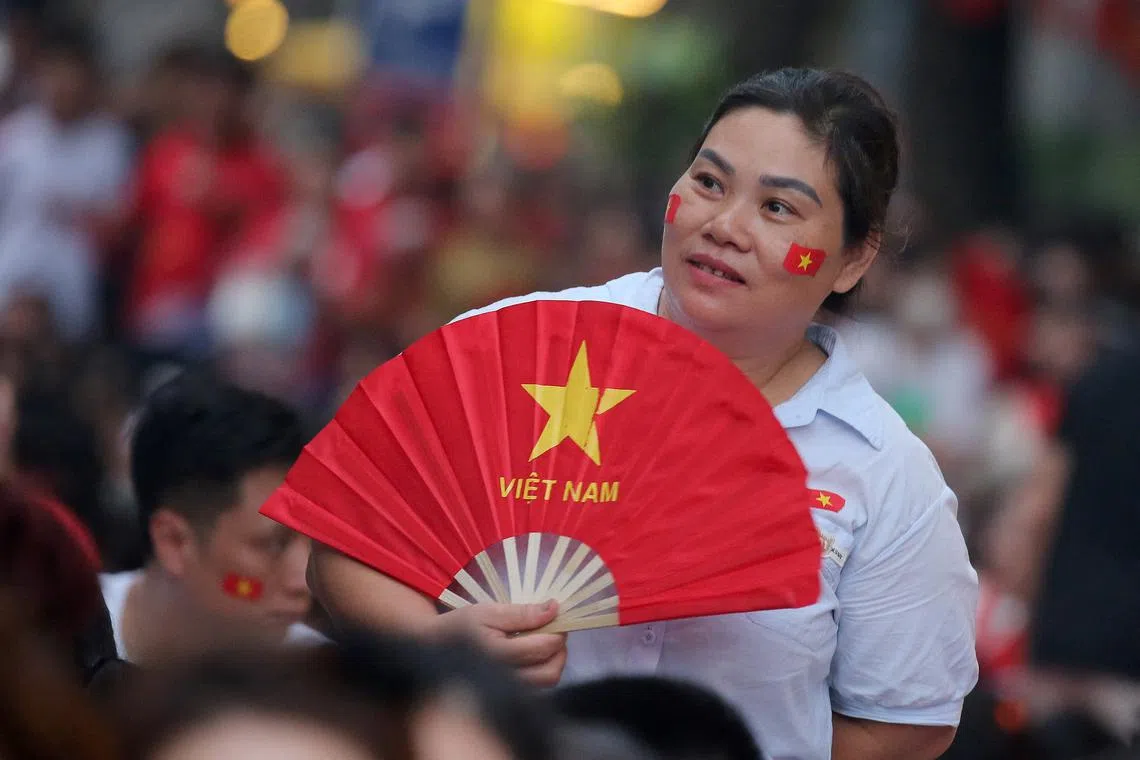Vietnam’s 80th national day parade sees a military eager to shed its Soviet roots
Sign up now: Get ST's newsletters delivered to your inbox
Follow topic:
As China draws the world’s attention this week with its grand military parade, Vietnam is holding its own historic event to show that its armed forces and defence industry are trying to march towards self-reliance.
In Hanoi, more than 16,000 troops have been drilling for weeks ahead of the country’s 80th national day. The spectacle has drawn crowds that camped overnight for a glimpse of soldiers flashing heart-shaped hand gestures and other light touches for a parade choreographed to build pride in the Communist Party.
Rolling down the street with them on Sept 2 will be Soviet-era tanks – relics of a force built for another age. But Vietnam will also display much newer gear: domestically made drones, cruise missiles and air defence vehicles from Viettel, the military’s telecommunications and defence arm and other state-run factories.
The hardware represents the early results of Vietnam’s push, launched in 2019, to refresh its arsenal and achieve self-reliance after decades of dependence on Moscow for military materiel.
Officials, including party chief To Lam, have cast military reform as a strategic imperative, promising a leaner, stronger force by 2030 – despite a defence budget more than 20 times smaller than China’s US$250 billion (S$321 billion) and an industrial base that cannot build combat aircraft or warships.
“If anyone expected that to happen quickly, they underestimated the hurdles,” said Mr Greg Poling, head of the South-east Asia programme at Washington’s Centre for Strategic and International Studies.
“From sensors to screws, everything in the Vietnamese military was built to Russian specification. They can’t just plug Western equipment into those systems – they have to build a whole separate military ecosystem.”
Vietnam’s efforts come amid unease with China, its powerful northern neighbour and top trading partner, whose South China Sea claims overlap with Hanoi’s and have fuelled years of stand-offs.
Last week, Beijing condemned Vietnam over a report that it had sped up island-building in the Spratlys, while Hanoi has repeatedly urged China to respect its sovereignty. Hanoi has sought closer security ties with the US, India and Japan as a counterweight.

People gather as they wait to watch a parade marking Vietnam’s 80th National Day anniversary, at a street in Hanoi, on Sept 2.
PHOTO: REUTERS
The South-east Asian country is projected to spend about US$11 billion on defence in 2025, a 30 per cent bump from 2024, although Hanoi has not publicly disclosed where it intends to spend that money.
Data shows that more than 80 per cent of Vietnam’s imported arms came from Russia between 1995 and 2022. Deliveries have slowed dramatically since the invasion of Ukraine.
That has left Hanoi scrambling. Its Russian aircraft are losing airworthiness certificates, and foreign maintenance crews from Ukraine have long since departed, said Professor Emeritus Carl Thayer at the University of New South Wales.
Vietnam has considered buying Lockheed Martin Corp F-16s for years but has hesitated given sensitivities with Beijing and Moscow, according to Bloomberg Intelligence. The December 2024 defence expo in Hanoi produced just 16 contracts worth US$286 million.
“High-level aircraft, fifth- and sixth-generation and major combatants at sea take years to integrate and Vietnam can’t make them,” Prof Thayer said.
Vietnam has 70 patrol and coastal warships, compared with more than 142 for China, according to a 2025 report from the International Institute for Strategic Studies. Vietnam has eight submarines to China’s 59, and many of the Chinese vessels are much more advanced than anything in Hanoi’s fleet.

People gather as they wait to watch a parade marking Vietnam’s 80th National Day anniversary, at a street in Hanoi, on Sept 2.
PHOTO: REUTERS
Vietnam’s air force likewise has only a few dozen modern multi-role combat aircraft, compared with nearly 2,000 in China’s inventory.
Viettel has become the centrepiece of Hanoi’s industrial push, and to coincide with national day, it showcased dozens of “Make in Vietnam, Made by Viettel” systems from self-propelled howitzers and battlefield communications to radar and air defence weapons. Reforms that took effect in 2025 allow private companies into weapons production for the first time.
“I’m very excited and especially proud because Vietnam has made our own kind of artillery system, which had never been done before,” Viettel Group engineer Do Manh Thang said of the howitzer design.
Another of the company’s headline systems is a surface-to-air missile battery that can simultaneously engage two targets. Viettel is also producing a mobile coastal defence system that links up to eight launchers armed with Song Hong anti-ship missiles that can strike targets up to 80km away.
Another bright spot in domestic production is drones.
Vietnam’s CT Group, which showed a prototype drone design at the 2024 defence expo, signed a memorandum of understanding to export 5,000 uncrewed cargo aircraft in partnership with a South Korean technology company and a domestic start-up has already begun marketing a foldable backpack drone to customers in the US and the Netherlands.

A woman waits to watch a parade marking Vietnam’s 80th National Day anniversary, at a street in Hanoi.
PHOTO: REUTERS
Foreign military contingents from Russia, Laos and Cambodia have joined rehearsals for the Sept 1 parade.
China is dispatching its People’s Liberation Army honour guard at Hanoi’s invitation, underscoring the awkward balance between showcasing sovereignty and preserving ties with its largest neighbour.
“If there is a war in the South China Sea, I’m not so positive about the result,” said Mr Nguyen The Phuong, a maritime security expert at the University of New South Wales.
“From the Vietnamese perspective, the main goal of military modernisation would be deterrence – trying to exert the maximum cost on China.” BLOOMBERG

